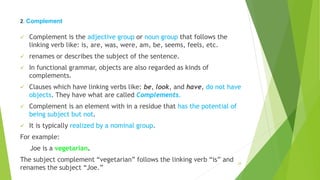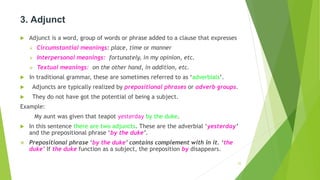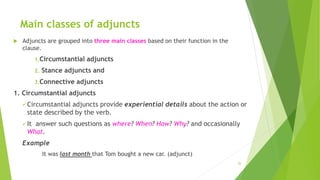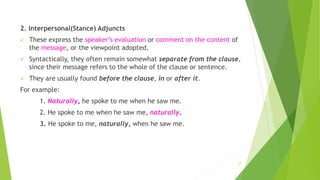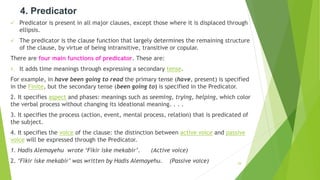This document discusses grammatical functions focusing on the roles of subjects and finite verbs in clauses. It explains different types of subjects (psychological, grammatical, logical) and how they interact with verbs to convey meaning. Additionally, it elaborates on other grammatical functions such as objects, complements, adjuncts, and the roles of finites and non-finites in sentence structure.
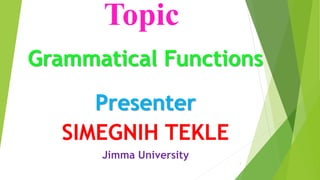
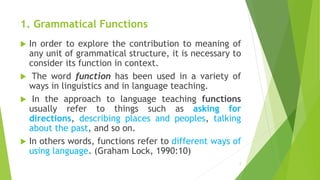





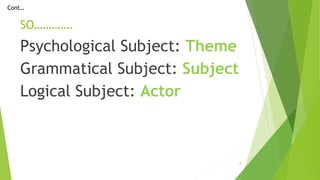

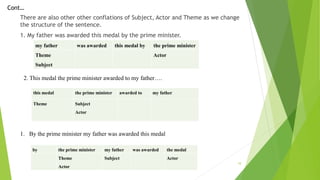
![Identifying Subject
Subjects normally precede the finite in the declarative clauses and
determine the person and number of the finite (if marked).
There are many formal characteristics used to identify subject.
These are:
I. Adding tag to the clause
The pronoun in the tag refers back to the Subject of the clause.
For example:
1. The kid[subject] has gone home, hasn’t he?[tag]
2. …the sea-serpent [subject] would overturn fishing boats,
wouldn’t it?[tag]
3. You[subject] have won the prize, haven’t you?[tag]
11
Cont…](https://image.slidesharecdn.com/functionalgrammarpresentation-160322121018/85/Functional-grammar-11-320.jpg)

![III. Five pronouns have special Subject forms (I, he, she, we, they) as
opposed to (me, him, her, us and them).
For example:
1.They didn’t really believe her.
2.She didn’t really believe her.
IV. In declarative mood clauses (clauses that make statements), the
Subject is normally the noun group which immediately precedes
the finite.
For examples:
1. We [subject] have [finite] already been searching for the answer.
2. You [subject] should [finite] insult your self with a sleeve.
13
Cont…](https://image.slidesharecdn.com/functionalgrammarpresentation-160322121018/85/Functional-grammar-13-320.jpg)
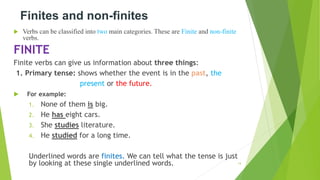

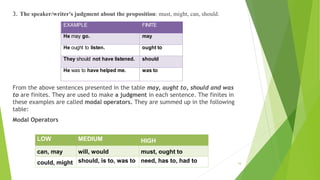
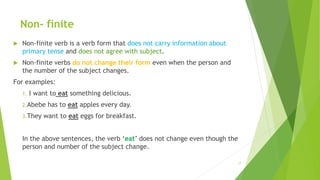

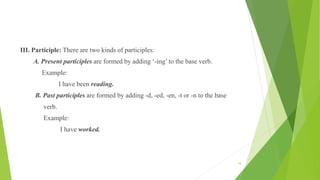
![Identifying Finites
1. Adding tag.
For example:
The kid[subject] has gone home, hasn’t he?[tag]
…the sea-serpent [subject] would overturn fishing boats, wouldn’t it?[tag]
You[subject] have won the prize, haven’t you?[tag]
On the above examples has, would and have served as finites.
2. If a verb group contains a Finite, the Finite will always be the first
constituent of the verb group.
For example:
1. She didn’t really believe them.
2. Philosophers have lately been explaining.
Note that if the verb group contains only one word, that word may function
as Finite.
For example:
A huge sea-serpent appeared at the bridge across the river. 20](https://image.slidesharecdn.com/functionalgrammarpresentation-160322121018/85/Functional-grammar-20-320.jpg)


![B. An indirect object is a noun, pronoun or a word that comes between
the action verb and the direct object.
answers the question “To whom?” or “For whom?”.
It doesn’t appear by itself without a direct object.
Example
Joe gave me [IO] an apple [DO].
The indirect object “me” answers “Joe gave an apple to whom?” “Me”
comes between the action verb “gave” and the direct object “apple.”
23](https://image.slidesharecdn.com/functionalgrammarpresentation-160322121018/85/Functional-grammar-23-320.jpg)
